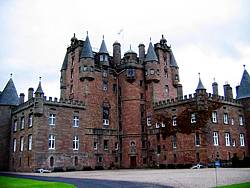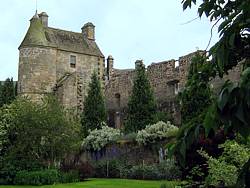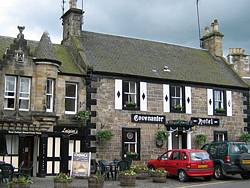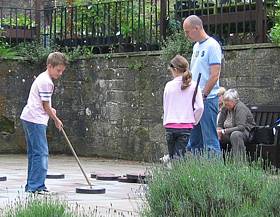 and reach thousands of daily visitors
and reach thousands of daily visitorsGreetings from the East of Scotland, where the days are currently long and the nights are short. Summer has begun with heavy rain throughout the UK and bad flooding has hit England, with more rain is forecast. The month of June has also been a time of major political changes, including appointment of the first Scottish Prime Minister – Gordon Brown – in more than 40 years. The new PM, a son of the Manse (his father was a Church of Scotland Minister) comes from the East of Scotland, so I thought this month’s Postcard should come from this part of the world.

Glamis Castle, Forfar – Birthplace of the Queen's Mother
Amongst many things, Scotland is famous for its castles. These reflect an important history of connections with power and those who have held power over the centuries. Our visit to Glamis Castle – pronounced Glams – offered glimpses of the ancestral home of the Bowes-Lyons family. Queen Elizabeth the Queen Mother is perhaps their most well known family member since her daughter – also Elizabeth – is now Queen of Great Britain and the Commonwealth. This is a place with distinctive royal and loyalist connections, where Anglican traditions are paramount“Well worth a visit.

Falkland Palace – Linked to the Jacobite Uprising
By contrast, Falkland Palace – less than 40 miles south – was the country residence of Stuart monarchs including Mary, Queen of Scots. Linked with Scotland's Catholic traditions, the place suffered persecution. In 1603 when James VI of Scotland became James I of England upon the death of an earlier Queen Elizabeth, Scotland and England retained separate parliaments; passed their own laws; enjoyed their own law courts; had their own national churches; their own ways of levying taxes and regulating trade; and pursued their own foreign policies. Scotland was practically two distinct nations with divisions between Highlands and Lowlands. James's attempts to persuade the clan chiefs to adopt the Protestant faith were a failure. They clung to the military habits of their ancestors, their Jacobite (Catholic) heritage and continued their use of the Gaelic tongue when most of Scotland had embraced English. James had a long-running quarrel with the Presbyterian Scottish Kirk and resented what he saw as their interference in matters of state. In 1638 a 'National Covenant' was produced on behalf of the Church of Scotland, backed by the nobility and gentry, who opposed the Anglican book of prayer. The Covenanters and their anti-Papist declaration brought the Scottish Kirk into direct conflict with the King and rule of law.

Covenanter Hotel, Falkland – Reflections of a Stormy History
That history is a backdrop to a new policy document launched some 400 years later by the Scottish Executive called Looked After Children & Young People: We Can and Must Do Better (see hyperlink to report below). Check out the outcomes for looked after children (those in foster and residential care) and actions set out to change the unacceptable status quo for young people.

Family Members Playing Outdoor Draughts (Checkers?)
Child and youth care is heavily influenced by
history – and we should never forget it! And history can also involve
fun and learning opportunities for children and young people! Plan a
visit to your local museum or other historic places as a learning trip!